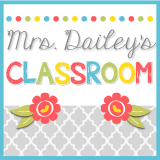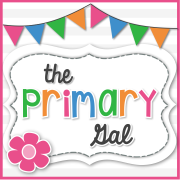Once again I am joining a great group of teacher bloggers to discuss The Daily 5: Second Edition by Gail Boushey and Joan Moser - lovingly known as The Sisters. Today's chapter is Chapter 3: The 10 Steps to Teaching and Learning Independence. This chapter is all about creating, teaching, and fostering students to work and learn independently.
Chapter 3 has been my favorite chapter so far. It made me:
1. Nod my head in agreement
2. Say "ohhhhh" as little light bulbs of new learning went on
3. Feel just a wee bit proud that I am doing many things to help my students become independent learners
The head nods started on the first page of the chapter when The Sisters were telling about the three different memory systems: visual, auditory, and kinesthetic. I feel that if there is one major idea that needs to be taken from this chapter, it is this:
"When information is stored in more than one of these systems, the memory is improved. Memory stored in the kinesthetic system evokes the longest lasting memory. To activate this system, teachers can provide kinesthetic learning experiences so children hear and feel the behaviors expected of them. Over time, this movement is stored in muscle memory and becomes part of students' default behaviors."
This statesman had me nodding my head over and over. This statement packs a punch. When we help students store things learned in muscle memory it is huge. Muscle memory is what allows a student to write their name without thinking about each letter, to know that the word "the" will always be t-h-e because they have written it frequently in authentic writing pieces, it's what helps older students learn how to drive a car without thinking about each minute step. Muscle memory helps to create automaticity!!! I could go on and on about the importance of muscle memory - but I won't - let me just say though - IT'S A BIG DEAL!!!
As I was reading about the first steps, 1: Identify What is to be Taught and 2: Set a Purpose and Create a Sense of Urgency, my first "ohhhhh" moment came at the end of step 2. I think I do a decent job of creating a sense of urgency in my students to become better students, but I need to work on creating a sense of urgency with more specific purposes - to become a better reader, to become a better writer, etc. if I did this, I think my Kinders would be better able to articulate the reason behind an activity - to be able to answer the question of "why should I do this?"
My next head nod came with Step 3: Record Desired Behaviors on an I-Chart. I liked how The Sisters shared that brainstorming correct behaviors may not be the best route for young learners as it makes the lesson go too long. Many times I find that when we brainstorm good (or even negative) behaviors my students end up saying the same things over and over, with maybe just a slight word variation. Also, for some of my Kinders this is their very first school experience, so they may not even know what behaviors are acceptable and which are not, so The Sisters suggest telling the students the positive behaviors and discussing each one. I also like how The Sisters encourage you to gradually increase the expectations each day - not all of them at once. So much easier for little ones to digest and learn. At the beginning of the year, my class and I make a behavior anchor chart using the books No, David! and David Goes to School by David Shannon as mentor texts. You can find many examples if you go to Pinterest and type No David anchor chart into the search bar. But after reading Chap. 3, I realize I want to create more specific anchor charts with visuals for my literacy and math areas. Here are two anchor charts I use each year. They both come from Kim Adsit's Reading Workshop Unit 1. The book bully one gets used all year long in my classroom.
Step 4: Model Most-Desirable Behaviors and Step 5: Model Least-Desirable Behaviors,Then Most Desirable Behaviors Again talk about modeling, modeling, modeling, and practicing, practicing, practicing. While reading step 5 I had an "ohhhh" moment as well as a "oh, thank you" moment when The Sisters spoke directly about kindergartners at the beginning of the year. They said, " These young learners need time to find out what school is all about, and showing them incorrect behaviors can be confusing." THANK YOU, THANK YOU! I know the importance of modeling and practicing, but I had given up on having my students model the incorrect behavior. My students who have a harder time resisting silliness always wanted to model the incorrect behaviors - not to learn the correct ones, but to get the biggest laughs and it would create this awful domino effect of everyone wanting to be silly.
Step 6: Place Students Around the Room and Step 7: Practice and Build Stamina did not bring any major revelations for me. I did, however, like the statement, "...we never let a timer or clock manage children's practice time." I will also confess to something - I usually don't introduce Read-to-Self until later in my Kindergarten year when most of my students can actually read books. I know and teach the three ways to read a book, but the investment just isn't there for them until they have books they can read. I will explain this further when the book study discusses Chap. 5.
Step 8: Stay Out of the Way is the hardest thing for me. I LOVE talking with my students during our rotations. I like to check in to see if there is anything important I need to know, see if they can explain things to me, and put out fires that inevitably happen at the beginning of the year. I need to stay out of the way more. It will be so hard though. I recently saw this chart on Pinterest and thought if we created this type of chart in the first few weeks, there might be less fires to put out and I can stay out of the way. This is from Kathy Griffin's Teaching Strategies. She calls it her What if... anchor chart.
Step 9: Use a Quiet Signal to Bring Students Back to the Gathering Place is straightforward. I have a beehive chime hanging over my small group table which I painted myself quite a few years ago.
Step 10: Conduct a Group Check-In; Ask, "How Did It Go?" is something that I don't do and that I want to do. I do think it is funny though that The Sisters talk about how younger students may still be in the egocentric stage and will always rate themselves highly. Yep! That's kindergartners for you! But I think as the year goes on, with practice and many discussions, some Kinders can get the hang of this.
Wow - sorry to go on so long, but I sure did like Chapter 3.
If you'd like to read more teachers' thinking, be sure to visit this chapter's hostess, Whitney Rippy,as well as check out the posts of all the teacher bloggers who have linked up. And a thank you to Brenda Frady for organizing this book study.



































